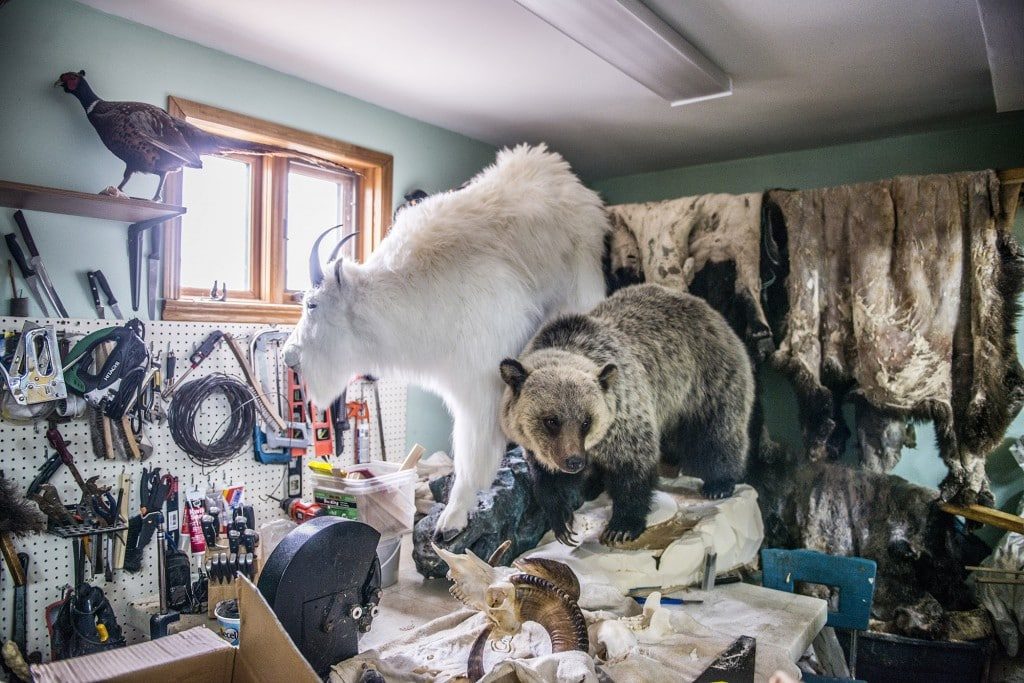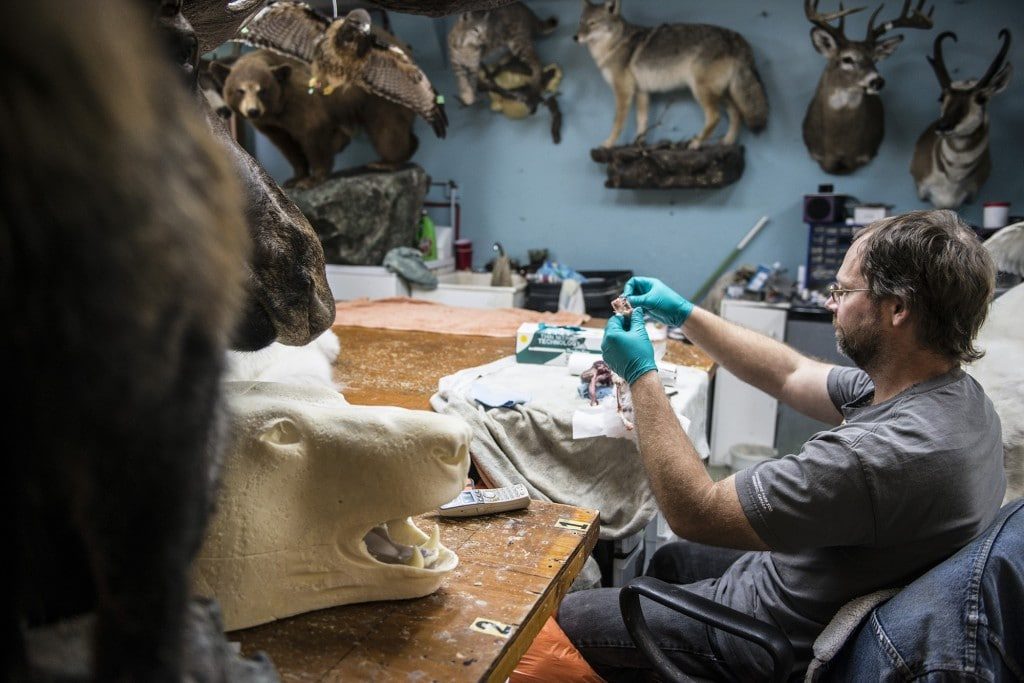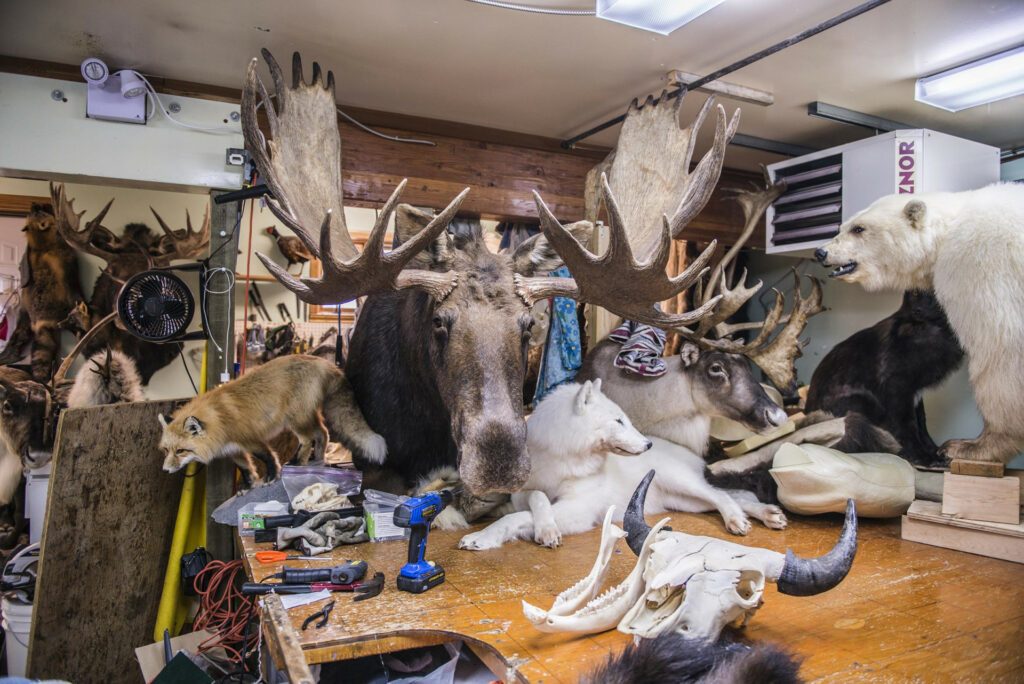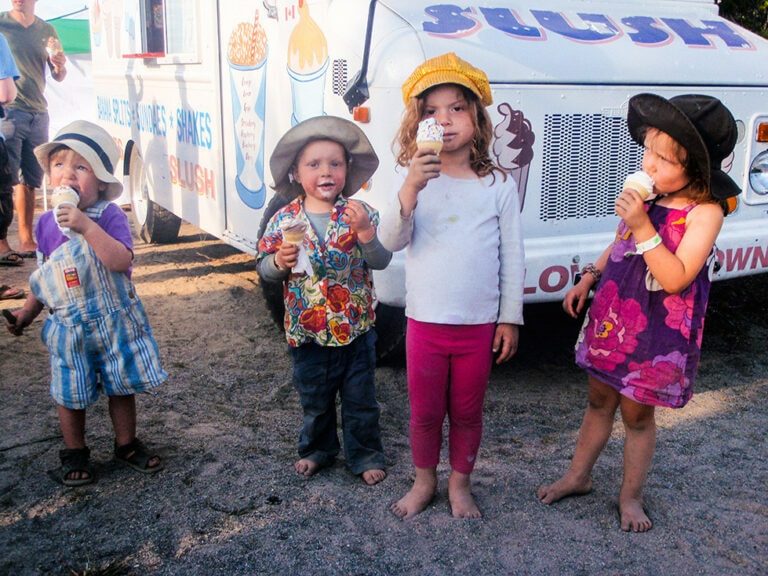




First Published in October, 2014
Italian multimedia artist Paola Pivi creates ambitious, complex installations that exhibit around the world. Last October, her show “Okay, You Are Better Than Me, So What?” opened the New York location of the Galerie Perrotin. The Upper East Side space was filled with signature pieces for Pivi: a series of neon-feathered polar bears, some flying, some dancing, some recumbent on the floor. The artist told journalists she’d worked closely with an unnamed Canadian taxidermist to create the bears and their unusual poses. “I want to achieve the best,” she told them. “When his [the taxidermist’s] hands are better than mine, I want to ask him if I can use his hands.”
That taxidermist lives in an anonymous compound in Kam Lake, and he’s perfectly fine with not getting name-checked by Pivi in the international art press. Greg Robertson’s got more than enough work, doesn’t much like attention, and would rather be left to his own devices. But earlier this year he let us look around his workshop while he worked away at a series of muskoxen for some American hunters.


Greg Robertson works on a muskox
The workshop is an organized riot of animals in various stages of completion, of molded mannequins that he alters to fit his skins, of plastic mouth parts and scrivener tools. There is a terrifyingly calm eight-foot grizzly bear over in one corner, a black bear mother and her cubs—the family killed last year at Prelude Lake—now preserved in play around a tree. There are seals, caribou, muskox, a gigantic moose, a pair of courting wolves mid-play, terminally grinning foxes, a snowshoe hare being chased by a bobcat, pine martins, whiskey jacks, a wolverine. There are few raging, snarling beasts. “I like to do my animals more passive,” Greg says. “I’d just think I’d prefer to do them a little more natural looking. I usually like to tell a story.” Walking the room, I see the stories, and all the finished animals seem vibrant, essentially alive. Even the dusty ones, forgotten in the corners, are springing in the middle of some gesture they’ll never complete.
Of course, they aren’t alive. They’re remains, re-animated. When Greg has spent hours adjusting and altering the mannequins, testing the skins over and over, patting, stroking, maneuvering the fur so it hangs just so, nailing, gluing, getting the animal’s balance correct—the hairs on the back of your neck might still prickle when examining the length of that grizzly bear’s claws, the teeth on those loving wolves, that sad little family of playful bears, even though you know full well they are an assemblage, fur artfully wrapped and accessorized.
I ask Greg: “Are you a craftsman, or an artist?”
“I don’t know,” he says. “Some people view it as an art, I guess.”

***
In another part of Yellowknife, in a semi-suburban house where the only sign of anything unusual is a partial ungulate mannequin hiding discreetly behind a garbage can by the workshop door, Greg’s younger brother Dean plans his next three projects.
“I can’t get it out of my head,” he says. Like his brother, he’s very quiet, very soft-spoken—but once you get him started… “I’m going to be doing a minotaur. I’m going to have it by my front door and as soon as people walk in…“ He laughs, quietly. “Everybody needs a minotaur in their house, don’t they? I’m gonna do a panda bear, a minotaur, and a sabre-tooth tiger. Those are my next three projects.” He laughs again. Quietly.
Both brothers were born in Saskatchewan but moved to Yellowknife in 1975. There was hunting in the family, and they became fascinated with animals brought back to the house. In his teens, Greg took taxidermy up as a hobby, then Dean caught the bug. “I just always really liked wildlife and nature,” he says, standing in his garage/workshop/studio, another panoply of arctic animals, mannequins, cupboards jammed with teeth and tongues. Most of the time we’re talking, his arm is wrapped companionably around a massive polar bear. I take the opportunity to pet it too. Not often you get the chance to stroke a huge-ass polar bear.
Like his brother, Dean is plenty busy and doesn’t really want or need attention. “Whenever you first start, you’re always trying to get work. Then you get your name out there, that you even exist. And then things change to the point where you don’t even want people to know you exist because there’s too much work.”
I mention that the polar bear seems to be looking at me. “The focus of every animal is the eyes, right? Typically, if you look at most of my animals, you’ll see the white on the edge. To me, that brings it right to life. You put the white in, you give it some expression.” As I walk around his workspace and look at the moose, foxes, bears, birds, it starts to feel like Dean’s eyes are staring out at me from all of them.
Dean has no hesitation about whether he’s an artist. “Greg’s taxidermy business started out mostly through outfitting. There, your business is from hunters, coming from mostly the U.S. I never really liked that because there’s not much art in that. It’s a typical head on the wall or a rug or something. So I went on my own to buy my own furs—I bought all these furs—and then create my own art pieces and then try and sell them.”
Who does he sell them to? “Right now, most of the money is from China. They’re the powerhouse in the world. They’ve got the most cash. And they love furs. In their culture furs are just everything. There’s a lot of superstitions and things over there and I guess, the white bear, they just gobble it up because it’s a symbol of purity. They don’t care about grizzly bears or black bears, it’s just the white bear. The caribou, I guess if you have a caribou head on your wall in China that’s supposed to bring you good luck. There’s all kinds of stuff like that, right?”
“Apparently Russia’s even bigger than China as far as demand, but I haven’t had any interest from Russia. They haven’t found me yet.”
Dean and his brother are low-key but major players in the North’s hunting economy. “It’s a risky business. So typically you shop in the same areas where you know the quality is going to be good and the hunter knows how to clean [the hides] properly. So I’ve got certain communities, in the NWT mostly, where I buy most of the quota. Some in Nunavut as well.”
So what they hunt, he buys?
“Pretty much, right.”
They’ve got too much business (seriously, don’t call them), they’re a little burned out from all the work, and yet Dean figures he and his brother are the last wave of taxidermists. Craft, art, whatever, it’s dying. Why?
“The main reason, overall, is the number of hunters is going down,” Dean, 43 years old, says. “There’s less interest in hunting, if you look at the stats. Less interest in hunting, less interest in taxidermy. And less of us learning the trade. I don’t see many young people learning the trade. I’m probably one of the youngest left.”
“The older taxidermists are retiring ‘cause they’re getting burned out. There’s too much work out there. (no really, leave them alone.) And once they all go and it comes on the next shoulders and my shoulders and then… after that I don’t see the next people coming.” Dean’s bummed for a moment, but then laughs his quiet mad scientist laugh. Angela the photographer has pulled out a drawer of mixed teeth, some of which he’s been hoarding for that sabre-tooth tiger he’s got planned. “I can’t sleep!” he says. “I’m thinking about that so much.”
Locally, you can see both brother’s work at the Prince of Wales Heritage Centre, where Greg is responsible for many of the tableaus, while Dean’s most prominent work is the eleven-foot polar bear in the Explorer Hotel’s lobby.
Like his brother, Dean is plenty busy and doesn’t really want or need attention. “Whenever you first start, you’re always trying to get work. Then you get your name out there, that you even exist. And then things change to the point where you don’t even want people to know you exist because there’s too much work.”
I mention that the polar bear seems to be looking at me. “The focus of every animal is the eyes, right? Typically, if you look at most of my animals, you’ll see the white on the edge. To me, that brings it right to life. You put the white in, you give it some expression.” As I walk around his workspace and look at the moose, foxes, bears, birds, it starts to feel like Dean’s eyes are staring out at me from all of them.
Dean has no hesitation about whether he’s an artist. “Greg’s taxidermy business started out mostly through outfitting. There, your business is from hunters, coming from mostly the U.S. I never really liked that because there’s not much art in that. It’s a typical head on the wall or a rug or something. So I went on my own to buy my own furs—I bought all these furs—and then create my own art pieces and then try and sell them.”
Who does he sell them to? “Right now, most of the money is from China. They’re the powerhouse in the world. They’ve got the most cash. And they love furs. In their culture furs are just everything. There’s a lot of superstitions and things over there and I guess, the white bear, they just gobble it up because it’s a symbol of purity. They don’t care about grizzly bears or black bears, it’s just the white bear. The caribou, I guess if you have a caribou head on your wall in China that’s supposed to bring you good luck. There’s all kinds of stuff like that, right?”
“Apparently Russia’s even bigger than China as far as demand, but I haven’t had any interest from Russia. They haven’t found me yet.”
Dean and his brother are low-key but major players in the North’s hunting economy. “It’s a risky business. So typically you shop in the same areas where you know the quality is going to be good and the hunter knows how to clean [the hides] properly. So I’ve got certain communities, in the NWT mostly, where I buy most of the quota. Some in Nunavut as well.”
So what they hunt, he buys?
“Pretty much, right.”
They’ve got too much business (seriously, don’t call them), they’re a little burned out from all the work, and yet Dean figures he and his brother are the last wave of taxidermists. Craft, art, whatever, it’s dying. Why?
“The main reason, overall, is the number of hunters is going down,” Dean, 43 years old, says. “There’s less interest in hunting, if you look at the stats. Less interest in hunting, less interest in taxidermy. And less of us learning the trade. I don’t see many young people learning the trade. I’m probably one of the youngest left.”
“The older taxidermists are retiring ‘cause they’re getting burned out. There’s too much work out there. (no really, leave them alone.) And once they all go and it comes on the next shoulders and my shoulders and then… after that I don’t see the next people coming.” Dean’s bummed for a moment, but then laughs his quiet mad scientist laugh. Angela the photographer has pulled out a drawer of mixed teeth, some of which he’s been hoarding for that sabre-tooth tiger he’s got planned. “I can’t sleep!” he says. “I’m thinking about that so much.”
Locally, you can see both brother’s work at the Prince of Wales Heritage Centre, where Greg is responsible for many of the tableaus, while Dean’s most prominent work is the eleven-foot polar bear in the Explorer Hotel’s lobby.










